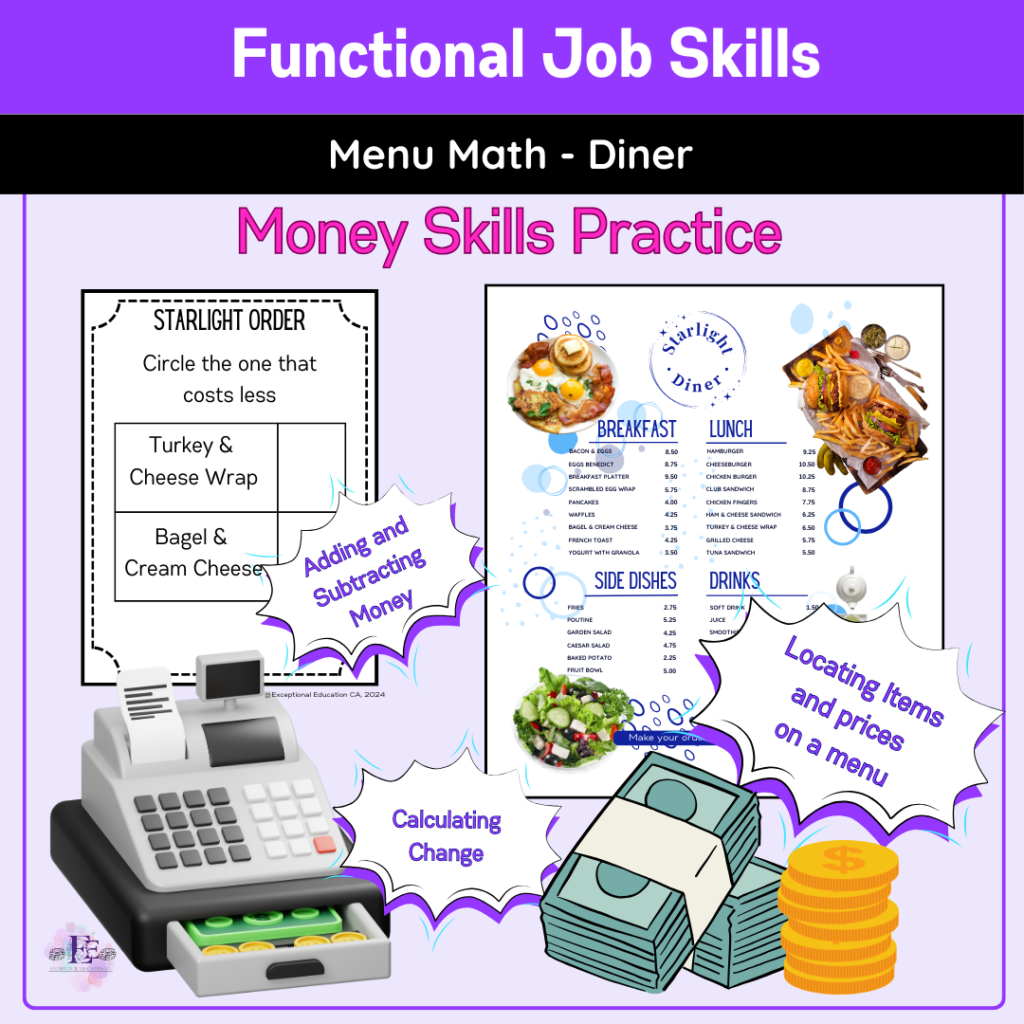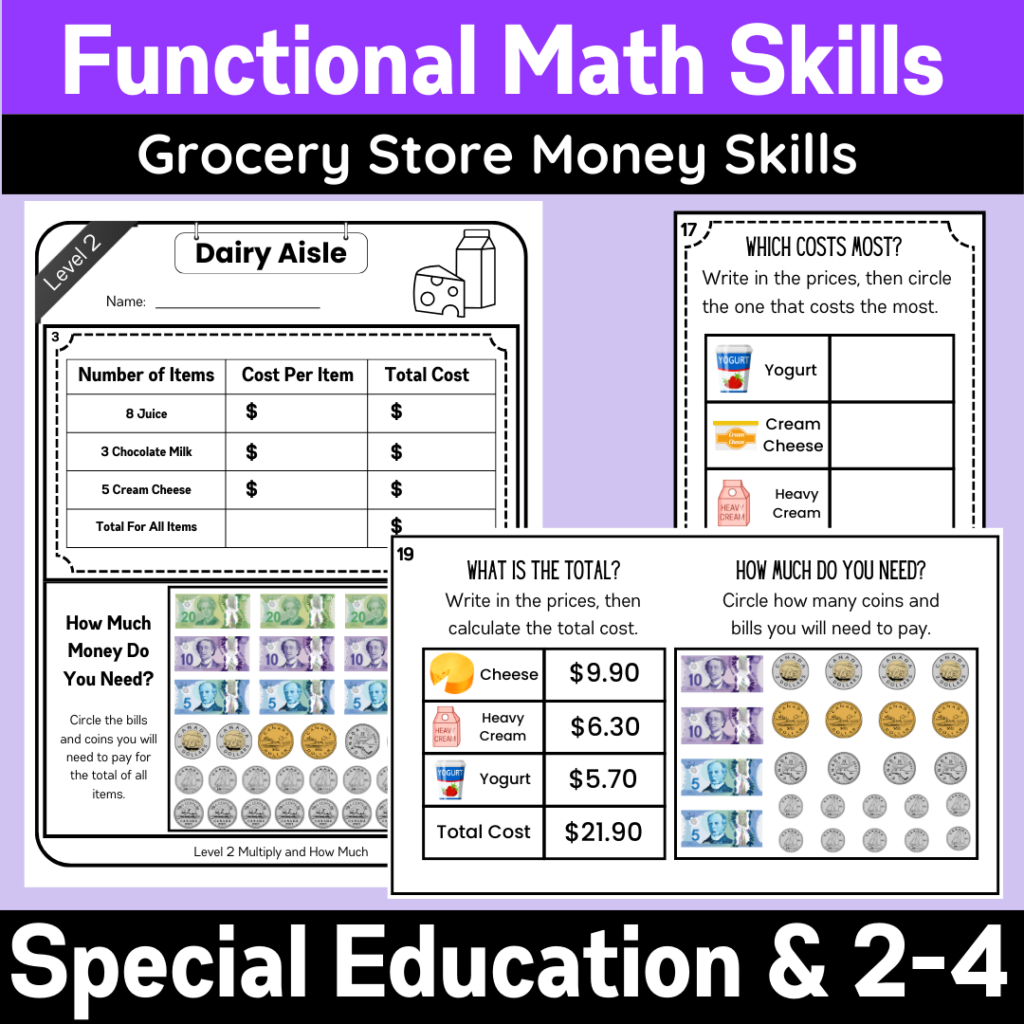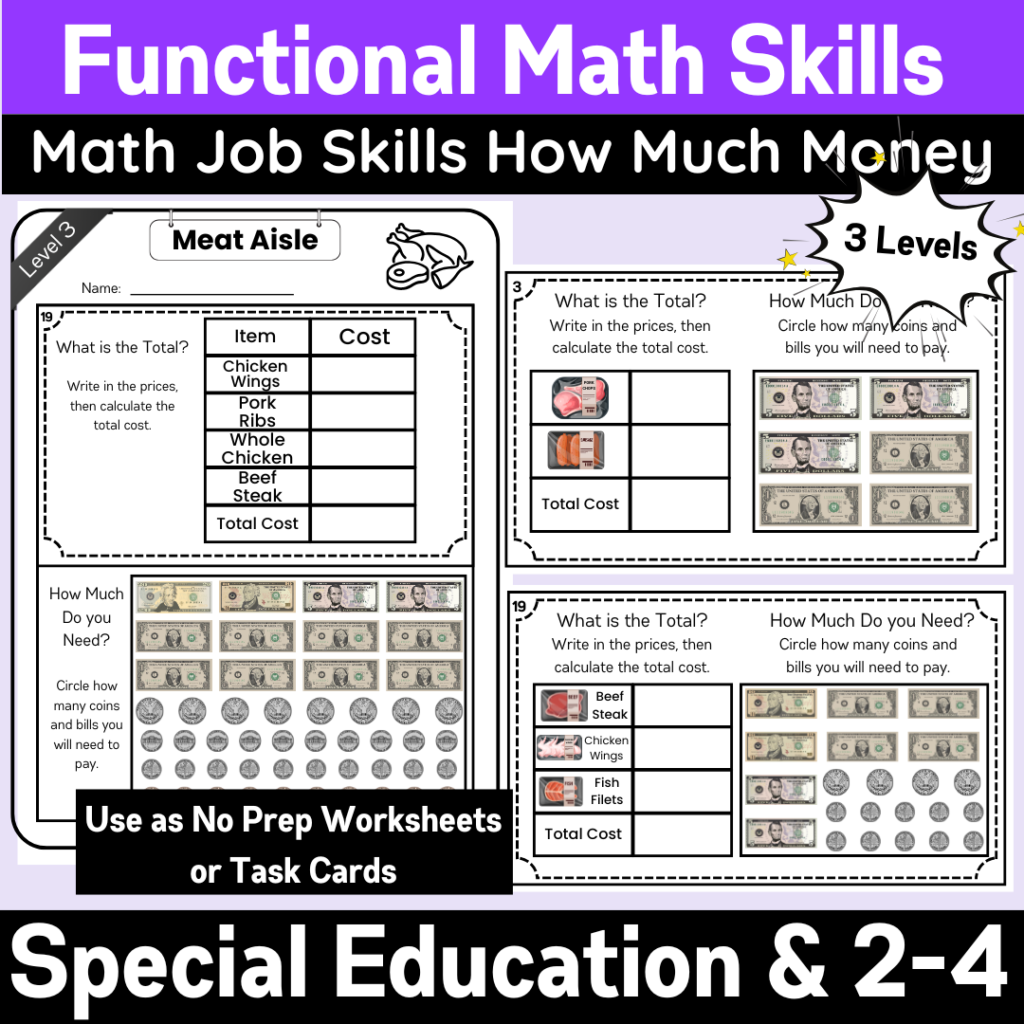Why is it important to teach money skills in a high school special education classroom?
In short, we teach money skills because it is a crucial part of preparing students in special education for independent living and future employment. However, abstract concepts like budgeting, making purchases, and calculating change can be challenging for many learners. By incorporating hands-on activities, structured practice, and engaging resources, we can help students develop confidence in using money in real-world settings.
Teaching money skills, especially with high school special education students, is one of my biggest focuses throughout the year. Money skills affect every aspect of a student’s life during and after school. Making daily purchases, shopping online, managing money, and other financial literacy skills are crucial for all students, but especially those with special education needs.
In this article, I will discuss 4 reasons why teaching money skills in a high school special education classroom is important, along with some practical strategies to help you as you plan for your own students.
1. Creating Real-World Experiences using Money Skills
One of the most effective ways to teach money skills is through real-world practice. This is also one of the most beneficial because it allows students to go through the motions in a predictable environment before they try out their skills in the actual setting.
Real-world practice allows students to practice, make mistakes, and learn through experience so that they gain valuable and meaningful connections with the money skills they are learning.
It can also help them with the social aspect of using money in a real life setting. For example, they can practice and role play by buying an item, paying for an item, and making sure they get the correct change.
They can also role play some aspects of shopping that can be less predictable like what to do if they are not given the correct change or if they want to exchange something. You can use scripts or prompts to help students with these scenarios before going into a store and practicing these skills in person.
Here are some engaging ways to create meaningful learning opportunities as you teach money skills in your special education classroom:
- Classroom Grocery Store: Set up a mini-store with labeled items, price tags, and play money. Students can practice shopping, adding totals, and making payments, while some take on the role of cashier to count change. This is also a good way to have students practice working in a grocery store. You can collect grocery items and have students stock shelves. Then they can make purchases using the products that they bring to the checkout.
- Community Outings: If possible, take students on trips to local grocery stores, coffee shops, or dollar stores. Give them a small budget and a list of items to purchase, helping them practice real-world transactions. This can include paying with cash and making sure they are given the correct change. Also, practicing using a debit or credit card and checking their receipt to ensure their total is correct.
- Role-Playing Activities: Assign students different roles—cashier, shopper, store employee, or manager—to simulate real-life financial interactions. Encourage students to make purchasing decisions and exchange money appropriately. I find I always focus on ensuring students are aware of their money so that they do not find themselves in a situation where they don’t know how much money they are giving or receiving back in change.
2. Using Engaging Resources to Reinforce Learning as you Teach Money Skills
There are many ways that you can build a stock of resources in your classroom to use for money skills instruction and practice. I collect boxes and containers from various items that I place in the classroom “store”.
You can create price tags, order sheets, menus, and various other real life resources. These allow students to practice their financial skills using manipulatives.
There are also lots of teacher created resources that you can purchase. These are printed and laminated so that they can be used and reused in your classroom. Purchasing resources from teachers can be beneficial because it saves you the time it takes to create the resource. It also gives you ideas of how to scaffold and sequence learning for each individual student in your room.
One of my favourite ways to practice money skills with engaging resources is by using a menu math or a grocery store math resource.
I use a menu math resource to set up a mock restaurant in my classroom. Students practice ordering off of a menu, calculating their total, and payment as a customer. They also practice the role of server by taking orders, filling orders, calculating a bill, and making change.
Adding Social Skills to your Money Skills Lessons
There is also a social skills component to real life situations. This can be so important in this kind of classroom simulation. Students practice the various social interactions that happen in both roles in a restaurant – serving and purchasing.
This also works with grocery store resources where students can practice being a cashier. This also includes various money skills, as well as social interactions appropriate to retail sales. As a customer, they will practice the same social interactions from a different perspective. Here students will get crucial daily money skills they will need and use for the rest of their lives.
Here are a few of my resources that you may be interested in so you can build your money skills in-class experiences.

This resource includes a menu from a diner. It has breakfast, lunch, side dish, and drink options. You will find various premade and blank order sheets. Students have to find an amount on the menu and write it on the order sheet. Students also have to calculate totals and make change. You can use this resource in a restaurant scenario to practice ordering food, as well as taking orders. Add play money to increase the experience.
This resource includes a page of items in a Dairy Aisle. Students go through three activity types using three levels of this grocery page. Activities include finding item prices, adding money, making change, determining how many bills and coins needed for a given amount, and multiplying money amounts. This resource is available with Canadian and American Denominations.


This resource is similar to the Dairy Aisle, however it contains only one activity from the resource using a meat aisle product sheet. This allows you to determine if the resource is right for you. You can also choose the activity that works best for your students. Students will find item prices on a menu, add money amounts, and determine how many bills and coins are needed to make a specific amount.
3. Teaching Strategies for Different Learning Levels
In special education, every student has a different ability level. This leads to unique and specific IEP goals for each student. Using varied and scaffolded teaching strategies helps students to access information where they currently are, and allows you to have a road map for how to move them forward with each of their IEP goals.
There are so many different teaching strategies that you can use with students. Here are a few ideas:
- Visual Supports: Use real money or printed visuals to help students understand coin and bill values. Use reference sheets for students to remember the values of coins and bills. Create a visual strip with a series of steps needed to complete a particular task. This can include images or just words, depending on the student’s reading level. This allows students to reduce the number of verbal prompts needed until they become familiar with a task.
- Hands-On Practice: Incorporate play money, grocery ads, and debit/credit cards to allow students to work with the actual items (or as close to them as you can). This allows students to experience shopping and working in a real and relatable way.
- Repetition & Routine: Reinforce skills by incorporating money-related activities into daily or weekly lessons. This can include grocery store, dollar store, coffee shop, restaurant, take out restaurant, cooking in the kitchen, and running a tuck shop in the classroom or school. There are so many ways to incorporate money skills into the student’s daily routine. The key is to be clear about which skill you are focusing on and make that the focus of each experience. Remember that there are multiple skills that can be worked on using these types of activities. Money skills, literacy skills, social skills, and following directions to name a few.
4. Encouraging Independence
Beyond classroom activities, it’s important to help students build independence with money management:
- Teach students to read receipts and compare prices. They should also be able to have a general idea of how much their bill should be. For example, if they went to the dollar store to purchase a few items and their bill is several hundred dollars, they should be able to recognize that something isn’t right. They should read receipts after their purchase to be sure they were not overcharged. It is also good practice for students to make an estimate of how much they think their bill will be before they go to the cash register, so that they are better able to determine if there has been an error before spending their money.
- Discuss the importance of making smart spending choices and sticking to a budget. Activities that allow students to determine how much they can buy when given a certain amount help them to take an abstract concept and make it a little more tangible. There are also some really good resources that help students determine if they have enough for their bill.
- Relate money skills to future job opportunities and independent living situations. One of the ways I love to do this is by starting the week with a recipe plan. We then go through the recipe, determine what ingredients we need, make a shopping list, shop for the items using a budget, and then make the recipe toward the end of the week. This can then be extended to creating a weekly meal plan, shopping list, etc. This helps students to learn the routine of planning and shopping for meals in the home.
Teaching Money Skills in a Nutshell
Mastering money skills empowers students to navigate daily life with confidence. There are many aspects of independent living that rely on experience with various money skills. By combining real-world practice, structured resources, and engaging activities, we can help students build independence in their lives outside of school through essential financial literacy skills.
Let me know your thoughts in the comments on teaching money skills in your special education classroom. What is working well for you? What are your current challenges?
If you are in need of a specific resource or want to read about a certain topic in the blog, please reach out by sending me an email! I would love to hear from you.
If you are interested in learning more about teaching money skills, check out this recent post where I talk about how to teach beginning money skills in a special education classroom.
Happy teaching!
